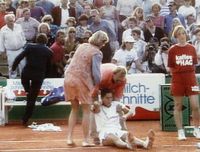On April 30, 1993, the world of tennis was shaken to its core when Monica Seles, then the top-ranked player and a rising star in women's sports, was brutally attacked during a match in Hamburg, Germany. This tragic event not only altered the course of Seles’ life but also left a lasting impact on the sport itself.
At just 19 years old, Seles had already made history by becoming the youngest-ever French Open champion at the age of 16. She was dominating women’s tennis, having held the world No. 1 ranking for an impressive 178 weeks. Seles had won her first Grand Slam singles title at the 1990 French Open, defeating her great rival, Steffi Graf, in the final. Her aggressive playing style and powerful groundstrokes made her a formidable opponent on the court.
However, on that fateful day in 1993, as she prepared to serve during a changeover, an obsessed fan of Graf stabbed Seles in the back with a boning knife. The blade penetrated her skin to a depth of 0.5 inches (1.3cm), causing not only physical injuries but also deep psychological scars. The attacker, who was later convicted of causing grievous bodily injury, received a mere two-year suspended sentence, a decision that sparked outrage among fans and players alike.
The aftermath of the attack left Seles traumatized. She struggled with depression and eating disorders, leading to her withdrawal from professional tennis for more than two years. During this time, the sport missed her presence, and her absence was felt deeply by fans who had come to admire her fierce competitiveness and unique style of play.
Despite the challenges she faced, Seles made a remarkable comeback in 1995. Her return to the sport was marked by resilience, and she captured her ninth Grand Slam title at the 1996 Australian Open. However, the emotional and psychological toll of the attack lingered, and her consistency on the court was never quite the same as it had been before the incident.
Seles’ last professional match took place at the 2003 French Open, a bittersweet end to a career that was once filled with promise and unprecedented success. She had won eight of the eleven Grand Slam singles tournaments she entered between the 1990 French Open and the 1993 Australian Open, a record that remains unmatched in the Open Era.
In 2009, Seles was inducted into the International Tennis Hall of Fame, a testament to her extraordinary contributions to the sport and her status as one of the greatest tennis players of all time. Her legacy is not only defined by her achievements on the court but also by her courage and determination to overcome the adversity she faced.
Today, as we reflect on the events of April 30, 1993, it is important to remember Monica Seles not just as a victim of a horrific crime but as a symbol of strength in the face of adversity. Her story serves as a reminder of the fragility of life and the importance of resilience, both in sports and beyond.
Seles’ impact on tennis is still felt today, inspiring a new generation of players who look up to her as a trailblazer in the sport. Her powerful baseline game, characterized by her unique double-handed forehand and backhand, changed the way the game was played and paved the way for future stars.
As we mark the anniversary of this tragic event, it is crucial to acknowledge the changes it brought about in the world of sports. The incident led to heightened security measures at sporting events, aiming to protect athletes from similar attacks. It also sparked conversations about mental health in sports, emphasizing the need for support systems for athletes dealing with trauma.
In the years since her retirement, Seles has continued to be an advocate for mental health awareness and has shared her story to help others facing similar struggles. Her journey from a promising young athlete to a survivor of a life-altering event is a powerful narrative that resonates with many.
As we look back on Monica Seles’ legacy, we celebrate her achievements and acknowledge the challenges she overcame. She remains a beloved figure in tennis, and her story serves as an enduring reminder of the strength of the human spirit.




